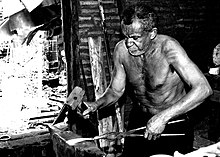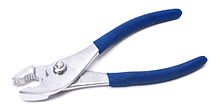Pliers
This articleneeds additional citations forverification.(April 2009) |



Pliersare ahand toolused to hold objects firmly, possibly developed fromtongsused to handle hot metal inBronze AgeEurope.[1]They are also useful forbendingandphysically compressinga wide range of materials. Generally, pliers consist of a pair ofmetalfirst-class leversjoined at afulcrumpositioned closer to one end of the levers, creating shortjawson one side of the fulcrum, and longerhandleson the other side.[1]This arrangement creates amechanical advantage,allowing theforceof thegrip strengthto be amplified and focused on an object with precision. The jaws can also be used to manipulate objects too small or unwieldy to be manipulated with thefingers.
Diagonal pliers,also calledside cutters,are a similarly shaped tool used for cutting rather than holding, having a pair of stout blades, similar toscissorsexcept that the cutting surfaces meet parallel to each other rather than overlapping. Ordinary (holding/squeezing) pliers may incorporate a small pair of such cutting blades.Pincersare a similar tool with a different type of head used for cutting and pulling, rather than squeezing. Tools designed for safely handling hot objects are usually called tongs. Special tools for makingcrimp connectionsin electrical and electronic applications are often calledcrimping pliersorcrimpers;each type of connection uses its own dedicated tool.
Parallel pliershave jaws that close in parallel to each other, as opposed to the scissor-type action of traditional pliers. They use a box joint system to do this, and it allows them to generate more grip from friction on square and hexagonal fastenings.[2]
There are many kinds of pliers made for various general and specific purposes.
History[edit]

As pliers in the general sense are an ancient and simpleinvention,no single inventor can be credited. Early metal working processes from several millenniaBCEwould have required plier-like devices to handle hot materials in the process ofsmithingorcasting.Development fromwoodentobronzepliers would have probably happened sometime prior to3000 BCE.[3]Among the oldest illustrations of pliers are those showing theGreek godHephaestusin hisforge.[4]The number of different designs of pliers grew with the invention of the different objects which they were used to handle:horseshoes,fasteners,wire,pipes,electrical,andelectronic components.
Design[edit]
The basic design of pliers has changed little since their origins, with the pair ofhandles,thepivot(often formed by arivet), and theheadsection with the gripping jaws or cutting edges forming the three elements.
The materials used to make pliers consist mainly ofsteelalloyswith additives such asvanadiumorchromium,to improve strength and preventcorrosion.The metal handles of pliers are often fitted with grips of other materials to ensure better handling; grips are usuallyinsulatedand additionally protect againstelectric shock.The jaws vary widely in size, from delicateneedle-nose pliersto heavy jaws capable of exerting much pressure, and shape, from basic flat jaws to various specialized and often asymmetrical jaw configurations for specific manipulations. The surfaces are typically textured rather than smooth, to minimize slipping.
A plier-like tool designed for cuttingwiresis often calleddiagonal pliers.Somepliers for electrical workare fitted with wire-cutter blades either built into the jaws or on the handles just below the pivot.
Where it is necessary to avoid scratching or damaging the workpiece, as for example injewelleryandmusical instrumentrepair,pliers with a layer of softer material such asaluminium,brass,orplasticover the jaws are used.
Ergonomics[edit]
Much research has been undertaken to improve the design of pliers, to make them easier to use in often difficult circumstances (such as restricted spaces). The handles can be bent, for example, so that the load applied by the hand is aligned with the arm, rather than at an angle, thus reducingmuscle fatigue.It is especially important for factory workers who use pliers continuously and helps preventcarpal tunnel syndrome.
Types[edit]
-
Diagonal pliersor side cutters
-
Lineman's pliersor combination pliers
-
Bent nose pliers
-
Electrical wire stripping and terminalcrimpingpliers
-
Crimptool for N, R-SMA, TNC connectors for RG174, RG58 and HDF/LMR200
-
Heavy duty crimping pliers formodular connectorthat have interchangeableRJheads
-
Hand crimp tool
-
Tongue-and-groove pliers,also known as channel-locks after the Channellock brand
-
Locking pliers,also known as a vise-grip
-
Circlippliers, for fitting and removingretaining rings
-
Round-nose pliers,for making loops in wires
-
Wiper pliers used to adjust the wipers and spring-sets on electro-mechanical relays.
-
Contemporary 'Pliers Wrench' with high mechanical advantage parallel-gripping jaws.
See also[edit]
References[edit]
- ^ab"Hand Tools:Tongs, pincers, and pliers".Encyclopædia Britannica.Retrieved14 March2013.
- ^"What are parallel pliers and how do they work?".Maun Industries.Retrieved27 April2023.
- ^Bellis, Mary."The History of Hardware Tools".Inventors.About. Accessed 16 December 2008.
- ^Warre Cornish, Francis (1898).A Concise Dictionary of Greek and Roman Antiquities.London: Spottiswoode & Co. p. 313.
External links[edit]
- How pliers are madeArchived29 March 2013 at theWayback Machine(video)
- Types of Pliers










